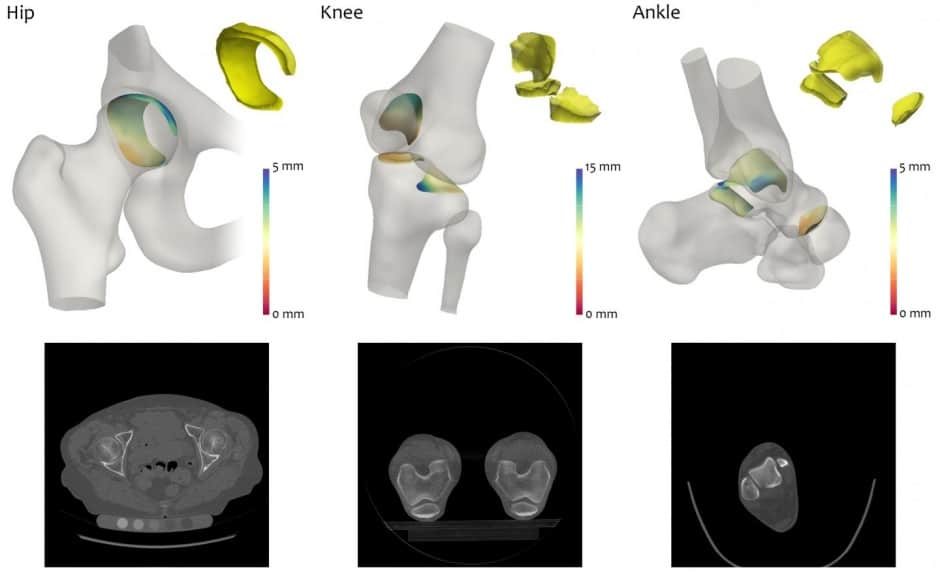
CT scans of hip, knee and ankle showing space between the bones in the joint compared with two-dimensional x-ray images. Image: Tom Turmezei
Osteoarthritis is a painfully common condition, but hard to treat effectively and to diagnose early. It occurs when the cartilage that coats the ends of bones and joints wears away over time, leading to immobility and pain. Pain killers can help, but the only truly effective treatment is through surgery to replace cartilage or to implant replacement joints.
Diagnosis of osteoarthritis depends on x-ray imaging to detect narrowing of space between the bones in the joint. But this effect can be gradual and subtle and difficult to spot, depending on the judgement and experience of the clinician. Lack of sensitivity of x-rays can also make it difficult to detect changes in the joint over time.
Tom Turmezei of the engineering department at Cambridge University is working on new ways to detect and monitor osteoarthritis. "In addition to their lack of sensitivity, two-dimensional x-rays rely on humans to interpret them," he said. "Our ability to detect structural changes to identify disease early, monitor progression and predict treatment response is frustratingly limited by this."
In a paper in the journal Scientific Reports, Turmezei and colleagues explain how they have turned to computerised tomography (CT) scanning to identify changes in the space between bones in the joints. CT scanning is an established technique, commonly used to look at internal organs and (with the help of contrast agents) blood flow, but it is not normally used to monitor joints. However, with its ability to construct detailed three-dimensional images from “slices” through the body, Turmezei believes it could be a powerful tool.
The Cambridge team has developed a technique called joint space mapping (JSM). The initial research was carried out on human hip joints from bodies donated to medical research. This revealed that the technique was more sensitive than the current “gold standard” for joint imaging with x-rays, proving at least twice as good at detecting small structural changes. The researchers have refined the technique using colour-coded images to illustrate the width or narrowness of the space between the bones across the whole joint.
"Using this technique, we'll hopefully be able to identify osteoarthritis earlier, and look at potential treatments before it becomes debilitating," said Turmezei, who is now a consultant at the Norfolk and Norwich University Hospital's Department of Radiology. "It could be used to screen at-risk populations, such as those with known arthritis, previous joint injury, or elite athletes who are at risk of developing arthritis due to the continued strain placed on their joints."
Moreover, Turmezei said, CT can be used with low doses of radiation, making it safer for more frequent scans to monitor patients over time. "We've shown that this technique could be a valuable tool for the analysis of arthritis, in both clinical and research settings," said Turmezei. "When combined with 3D statistical analysis, it could be also be used to speed up the development of new treatments."




Poll: Should the UK’s railways be renationalised?
The term innovation is bandied about in relation to rail almost as a mantra. Everything has to be innovative. There is precious little evidence of...